It's widely known that link building campaigns play a crucial role in achieving higher organic rankings.
Which aspect of link-building is the most important?
There isn’t one. No single activity or process guarantees success. Instead, building quality links requires a coordinated and consistent effort throughout the whole backlinking campaign.
That’s how we run it at my link building agency Editorial.Link, and I’ll share how in this guide.
Our guide provides insights on:
- what link-building campaigns are
- how to set meaningful link-building goals
- how to find prospects for your campaign
- what assets to leverage
- how to nail link-building outreach
- how to monitor your results.
What Is a Link Building Campaign?
A link building campaign is an organized effort to increase the number and quality of inbound links pointing back to a webpage.
It involves a series of activities such as identifying potential link sources, creating high-quality content, reaching out to the prospects, and monitoring progress.
The aim of backlinking campaigns is to boost the SERP performance of your content. As search engines like Google use links as a ranking signal, increasing their number can improve the position of your web pages in the search results.
How to Create a Link Building Campaign?
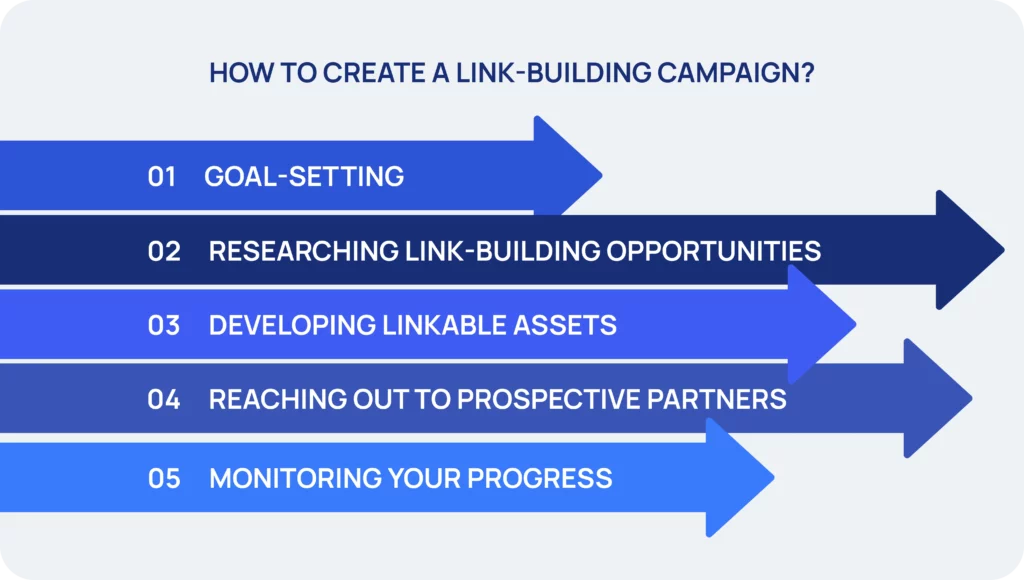
A successful link-building campaign consists of 5 key steps:
- goal-setting,
- researching link-building opportunities,
- developing linkable assets,
- reaching out to prospective partners,
- monitoring your progress.
Let's have a look at each of them, one by one.
✔️ Set The Goals
To start with, clearly define your goals and objectives.
This will give your link-building campaign focus and guide your actions at the subsequent stages of the campaign. Goals are also necessary to measure your progress once your campaign is up and running.
How do you set clear and measurable goals?
It may be tempting to go for simple goals, like build 10 links by the end of the month.
Building links, however, is only a means to an end - boosting the search engine performance of your content. So to set truly meaningful goals, tie them to your organizational goals, like increasing traffic to drive sales.
An example of a good goal could be ‘increase organic traffic by 21% by the end of Q3'.
Evaldas Mockus, the VP of Growth at Omnisend warns against setting goals that are too big or ambitious. Instead, he recommends starting with smaller objectives while continuously refining your processes that would support your link-building:
To witness high pace progress, it is essential to begin with smaller goals when establishing a strategy.
For instance, if your long-term objective is to double traffic, initially, you should focus on developing a systematic approach for creating hundreds of backlinks and publishing or updating numerous blog posts.
Especially if you work with OKR’s – it is easy to get an idea about unlimited potential, but in reality without small steps, you cannot achieve big wins.
🤔 How To Find Link Building Campaign Ideas?
Once you set your goals, it's time to look for prospective websites, bloggers, and influencers that would be willing to link back to your web page.
There are a few ways to do this.
Reach out to your partners and leverage LinkedIn
Samantha North, an SEO consultant, recommends looking for prospects in your network first:
Start by targeting some low-hanging fruit – your partners. It’s easy to pitch them with guest posts or niche edits ideas, because you already have an existing relationship. Especially if they’re affiliates because your website ranking higher will drive them more traffic and revenue. It’s a win-win.
Cold emails often go ignored, but LinkedIn offers a powerful way to get the attention of potential link-building partners. This approach works especially well if you already have a strong personal brand presence on LinkedIn. Just connect with any link-building partners of interest and drop them a friendly, non-spammy DM. You’ll be surprised how well it works.
Research competitor's link profiles and identify backlink gaps
If someone is linking to your competitors, they're likely to link to your site as well, so research their backlink profile for inspiration
To do this, leverage your SEO software.
In Ahrefs, use the Backlinks report.
The feature allows you to see all the websites that link to your competitors.
You can easily filter the results by link type (e.g. dofollow/nofollow/UGC/Sponsored), Domain Rating, and domain traffic so that you can easily view only the high-impact sites.
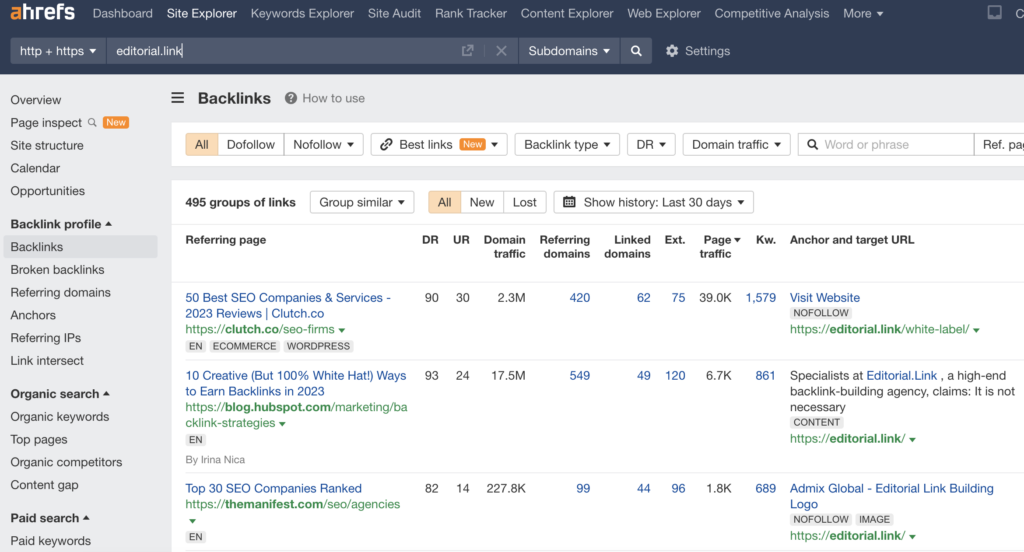
Semrush also offers the Backlinks report with similar functionality, and you can also do it without a subscription in Ubersuggest.
Analyzing the backlink profiles of your competitors one by one can be a bit of a drag.
Fortunately, you can save yourself a fair bit of time and effort by using tools that analyze the gaps between your backlink profile and your competitors. That’s the easiest way to find pages that link to them but not you.
Have a look at the Ahrefs Link Intersect tool:
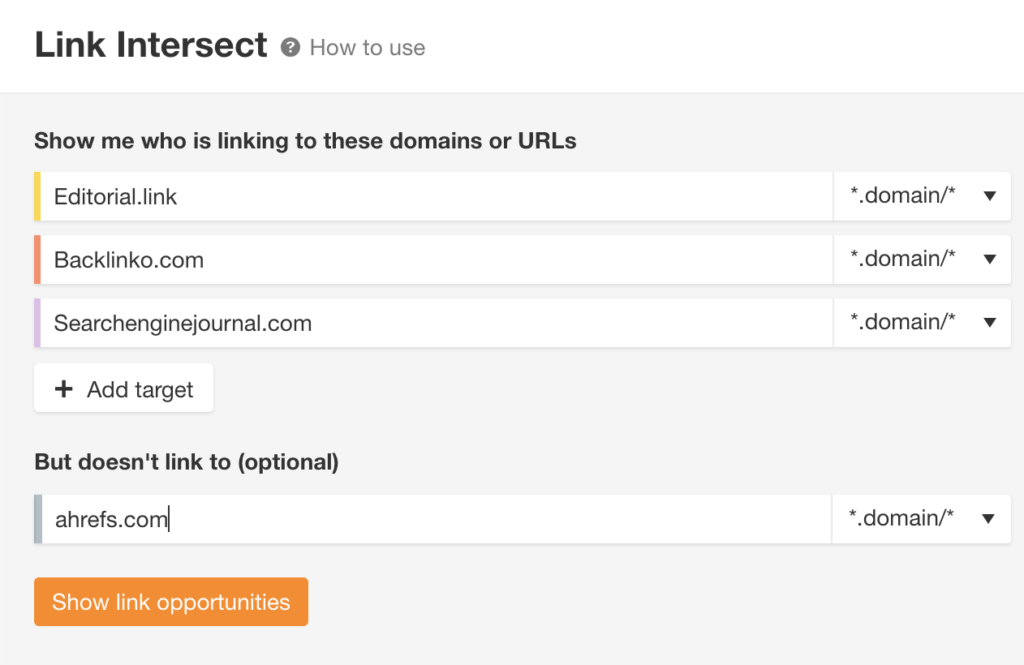
When you enter your domain URL and your key competitors, here’s what you get:
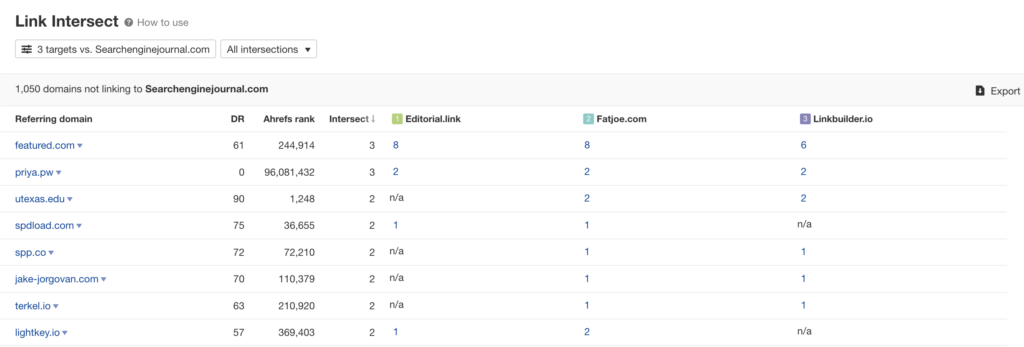
Backlink Gap in Semrush and Backlink Opportunity in Ubersuggest work in exactly the same way.
💡A quick reminder though: Chasing competitor links isn’t enough, because all you’ll be doing is playing catch-up. To outcompete them, build links that they don’t have, especially, when dealing with top-tiered websites.
Look for broken links
Relevant sites with broken links are attractive prospects because they're already linking to a page that's related to yours. And by helping webmasters find and replace their broken links, you're doing them a favor. This increases your chances of success.
🔗 Related article: Broken Link Building 2026: Our Detailed Guide
How do you look for broken links?
Type the domain you want to get a link from in Ahrefs Site Explorer, select Broken Links from the sidebar menu, and job done.
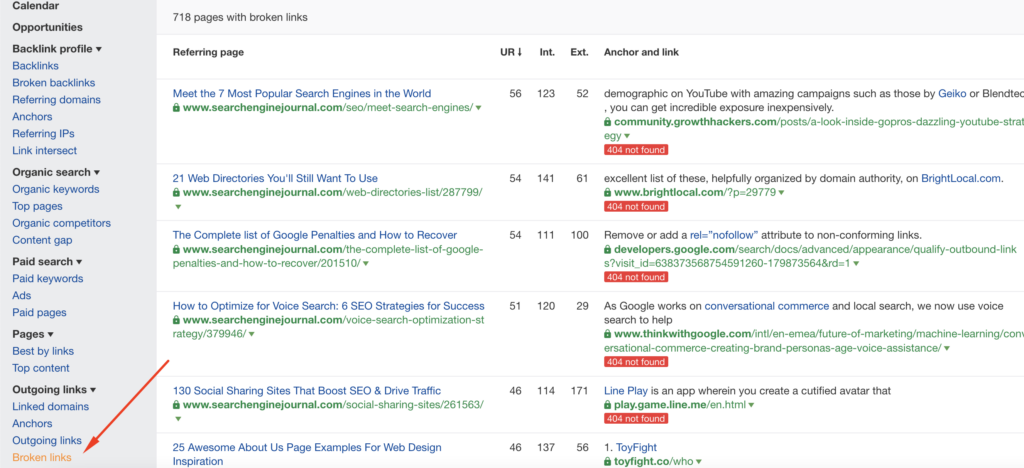
Alternatively, you can use a Chrome extension, like Broken Link Checker, but this requires visiting the actual page that you want to inspect.
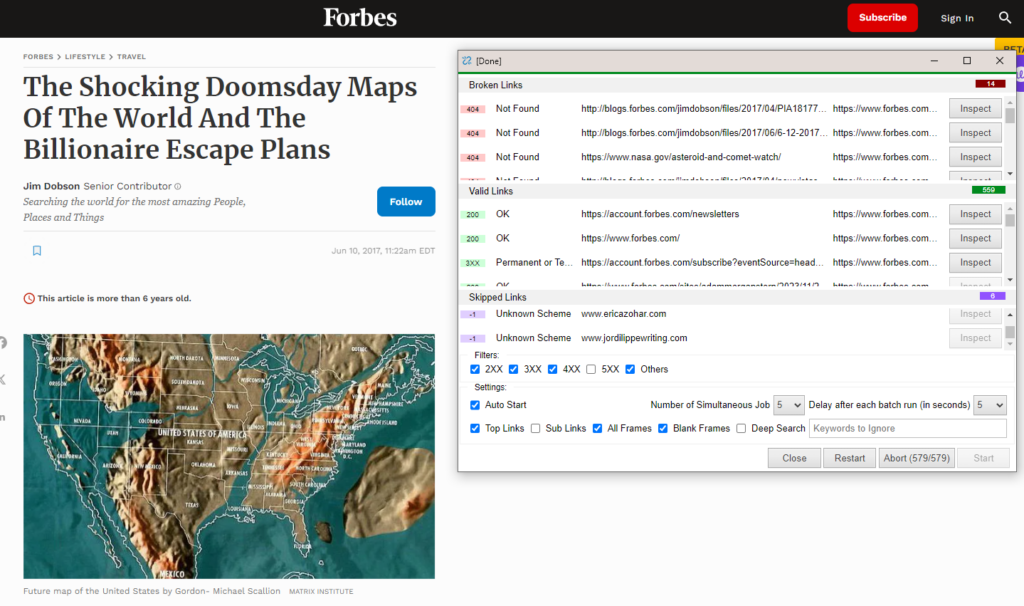
Once you identify broken links, you may be lucky to have a similar resource available on your website. If not, you may want to create such an asset from scratch or use a web archive to restore it.
It goes without saying you should also be monitoring links pointing to your site and immediately restoring lost ones.
Monitor unlinked brand mentions
Unlinked brand mentions are another low-hanging fruit.
Claiming unlinked mentions is one of the most effective link-building methods.
It works well for established brands. Websites that mention your brand without a backlink already know about your business and how it solves specific challenges, making negotiations easy.
There are a lot of tools you can leverage to monitor brand mentions. Antonio recommends Mention, but you can also find them with SEO tools.
Here’s how you can do it in Ahrefs:
💡Pro Tip:
- Type “your brand name” and filter to search only for “in content” results.

2. Set the filters (DR, ST, language, etc.)
3. Add your domain URL in “Highlight unlinked”. This will highlight the results that mention your brand but without a link.
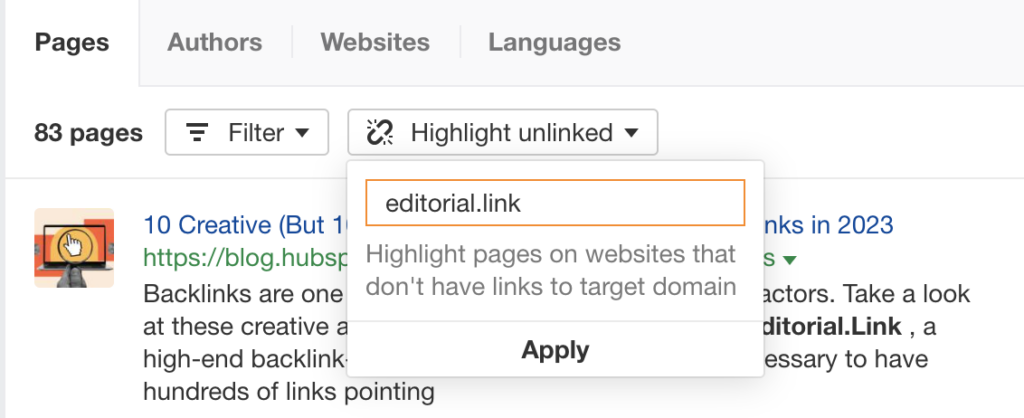
4. Export only highlighted pages.
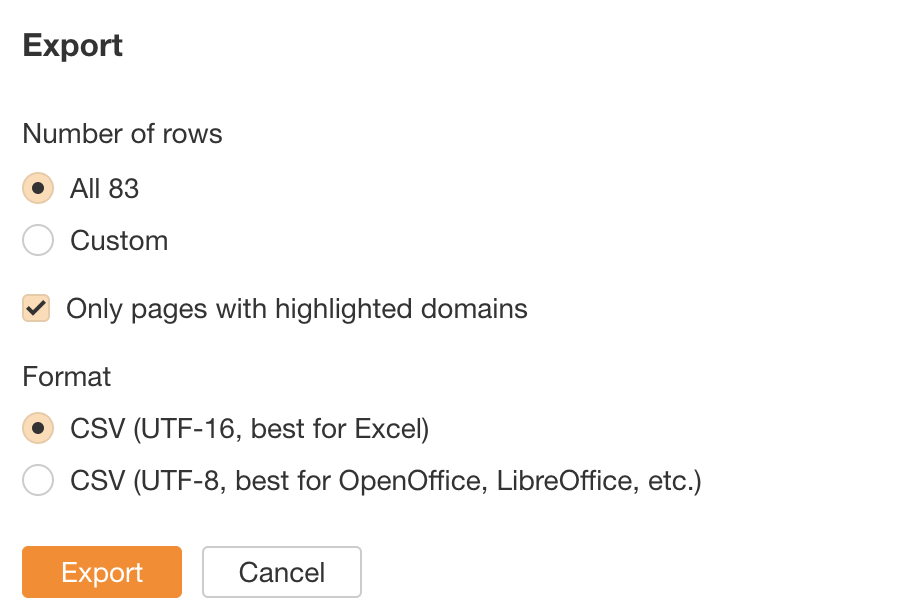
Create Link-building Assets
Having identified your prospects, it’s time to create assets that they might be happy to link to.
🔗 Related article: Linkable Assets: Winning Tactics for 2026
Guest posts/contributed articles to pitch.
Guest posts are articles that you write for another website or blog. In exchange for contributing a valuable piece to their content, you get a backlink to your site.
However, securing guest posting opportunities, especially unpaid ones, is not always an easy.
How do seasoned link-building pros go about it?
I asked Irina Maltseva, Founder at ONSAAS and Growth Lead at Aura.
When pitching guest posts, personalize your approach. Research the target blog thoroughly to understand its content style and audience preferences. Tailor your pitch to demonstrate how your post will add value to their readership, addressing a gap or presenting a fresh perspective on a relevant topic.
A well-researched, customized pitch not only shows your genuine interest but also significantly increases the chances of your guest post being accepted.
Infographics
When done well, infographics are a proper link magnet because they communicate a wealth of information in an easily digestible and visually appealing format.
Here’s a good example:
This interactive infographic on data breeches and hacks has attracted 5.5k links from 2.0k domains.
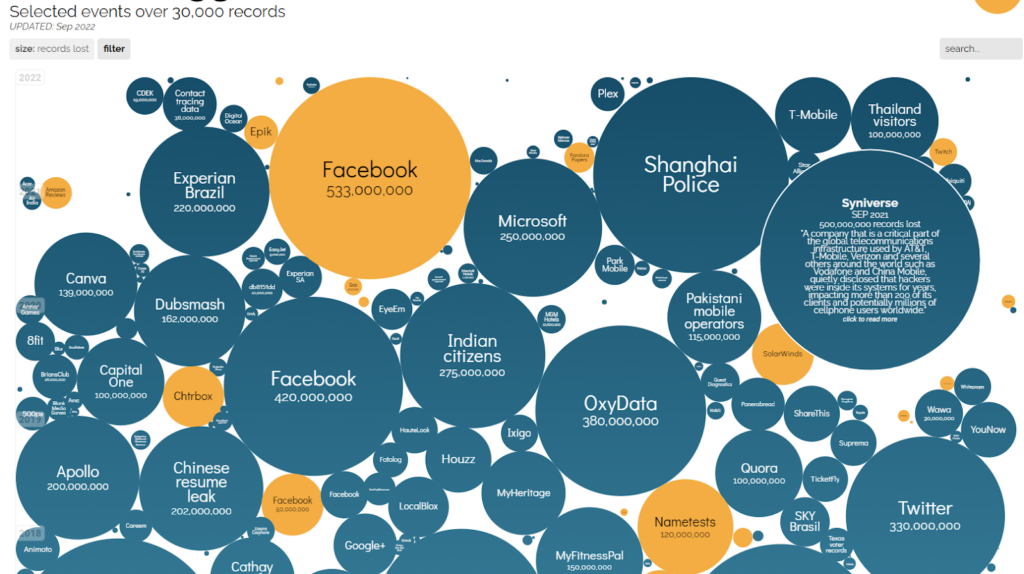
There are two approaches to creating infographics.
One way is to create infographics related to trending keywords and share them with websites that cover the topic to enhance their content.
Alternatively, you can research infographics with lots of backlinks, improve them, and pitch them to the sites that have linked to the originals.
You can go one step further and reach out to your prospects with guesto-graphics.
What are they?
In short, they’re bespoke infographics in the niche that your prospects write about. You then reach out to them and ask if they want to link back to it. To add even more value, you offer to write a mini guest post around it.
Statistics & research
Quality research and statistics are one of the best link sources.
They are very attractive to bloggers and freelance writers because they help them support the argument that they’re building and make their writing more credible.
Just check out the State of Marketing by Hubspot to see what I mean. The report has earned over 28k links from 8k domains.
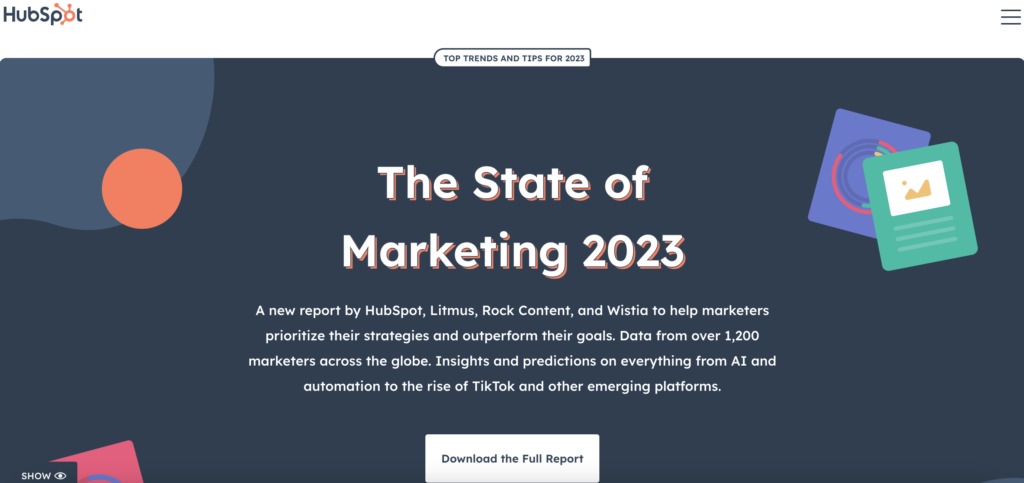
What if you don’t have the resources to conduct original research?
Research and collate data already published by others. In this way, you make it easier for writers to find the information they need and the odds are they will link to your content, not the originals.
For example, the article by Adam Connell below, published only 20 days ago, doesn’t contain any original data, and yet is sitting in the 4th place in Google SERP at the moment and has been linked to 57 times.

Case studies and reviews
Case studies, just like original research, provide valuable and practical information for writers who will be happy to link back to them to make their stories stronger.
For example, Brian Dean’s classic case study of how he used the skyscraper technique to boost his web traffic has attracted over 8.7k backlinks from 2.5k websites.
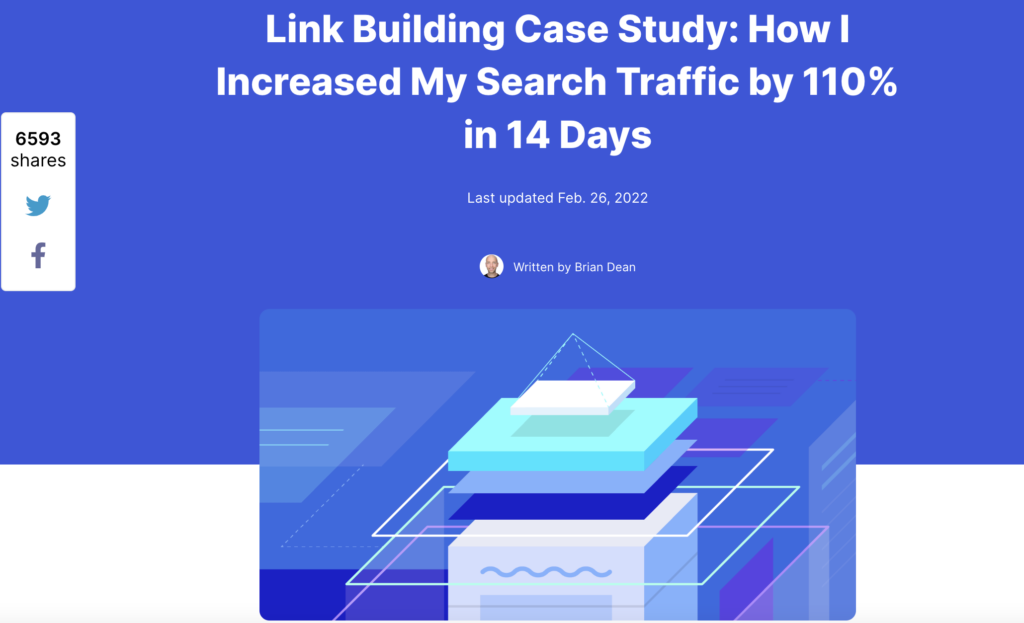
How about reviews?
Write an accurate and honest review of your prospect’s product or service, publish it on your site, and send it to them. If they’re happy with it, they’ll share it on their social media and link back to it.
You can also combine the two by writing a case study involving a product. For example, you can collaborate with a SaaS product vendor on a case study featuring their tool.
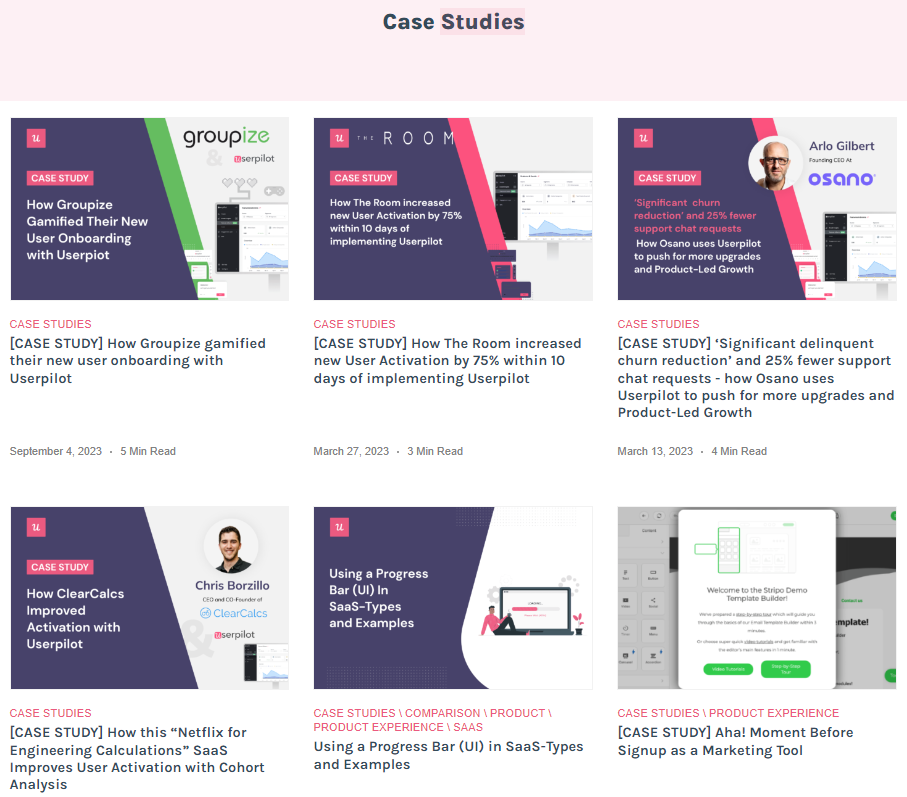
Interviews and podcasts
Interviews with industry experts and thought leaders do wonders when it comes to link-building.
What makes them so effective?
First, they add value to your content by providing unique and credible insights that may not be readily available elsewhere. This alone is enough to attract links.
Second, when you feature someone in an interview or podcast, they’re likely to share the content on their social media to acknowledge the exposure you’ve given to them. This will increase its visibility, and bring referral traffic and links.
Also, why not reverse the table and appear in podcasts as a guest to secure links from their episode pages?
Research podcasts relevant to your niche and reach out to the hosts to pitch yourself out as a guest.
To find reputable podcasts in your area of expertise, use Google, popular streaming and podcast platforms like Spotify, or SEO tools.
Make sure to vet them before pitching as it’s not worth wasting your time on podcasts that don’t offer guest appearances, have limited reach, or worse, aren’t running anymore.
🚀 Develop a Bulletproof Link-Building Outreach Strategy
Outreach is the next step in the backlink campaign.
I mean you can sit and wait for people to link to your assets organically, but that’s not exactly the best way to realize their full-link building potential.
To do that, promote them actively by reaching out to prospects and asking for a link.
Let’s look at a few tips on how to do it effectively.
Personalize emails and focus on value for prospects
Personalization is the name of the game when it comes to outreach.
In fact, Editorial.Link data shows that well-personalized outreach emails can achieve a 45% response rate, while generic ones only 8.5%.
Wondering why?
Just look at these two sample emails from Ben Goodey, an SEO strategist and founder at How the F*ck.

The second email greets the reader with a personalized opening line, is more specific, and shows you’re familiar with the person’s work.
There’s one more thing that makes the second email better.
It offers value by identifying a gap and offering a solution in the form of a guest post.
This is crucial: when reaching out, give your prospects a good reason to link back to your content.
Assuming your linkable assets are of high quality and value, this shouldn’t be difficult though.
Build relationships with influencers in your space
Building relationships with influential figures in your industry has some long-term benefits.
It’s a chance to regularly secure high-quality backlinks, increase your own authority, and boost your reach and visibility, to name just a few.
How do you build such relationships?
Influential prospects may be initially reluctant to link back to pages they don’t know. It’s too much risk for their hard-earned reputation. What’s more, they get flooded with collaboration requests, so cold emails won’t cut it.
That’s why start by engaging with their content on social media to get noticed. Once you get on their radar, reach out and offer them something of value, like a free link. Only then ask for a link.
Partner with organizations sharing your ethos
When building relationships, focus on people and organizations that share your values.
In marketing, it’s crucial to partner with organizations that align with your values. This approach ensures the links you build are not only effective but also authentic, which really strengthens your brand.
Aim for quality in your partnerships rather than quantity. Collaborate on projects that resonate with both your audiences, like shared content or events. Regularly evaluate these partnerships and be ready to adapt. This strategy does more than just build links; it enhances your brand’s credibility and trustworthiness.
Monitor Links and Measure Progress
The last stage in the link-building process is all about measuring your progress. This includes tracking the new backlinks and their impact on your key metrics.
Use ranking tools to track keyword improvements.
If your objective is the improve your rankings for specific keywords, use a tool like Ahrefs Rank Tracker.
It’s simple to use. All you have to do is add your domain and the keywords you want to track.
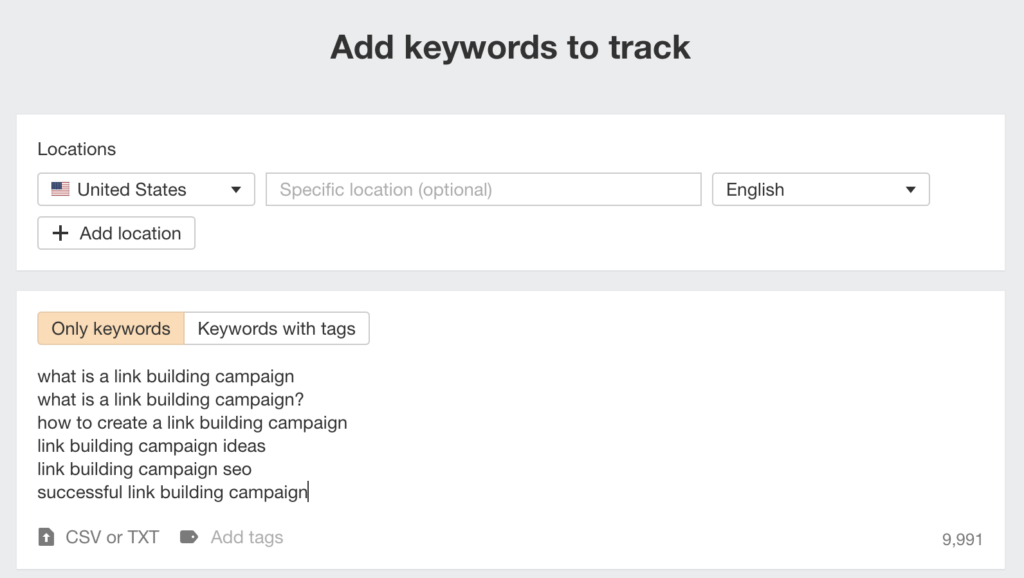
The report that Rank Tracker generates offers insights on:
- Share of Voice (SOV) - the percentage of clicks from organic search traffic landing on your site
- Average position - for all the tracked keywords
- Organic traffic - over time
- SERP features - like featured snippets, top stories or thumbnails - 15 of them in total.

You also get detailed insights about the performance of each tracked keyword.
Semrush offers similar functionality in its Position Tracking tool, and if you want to look up individual keywords, why not use Ahrefs free Keyword Rank Checker:

Check Google Search Console for new backlinks
Google Search Console is a free simple tool that enables you to track basic link metrics, so you can use it to identify new links pointing to your domain.
After clicking on Links in the sidebar menu, you get information on:
- Total external links
- Top linked pages
- Top linking pages
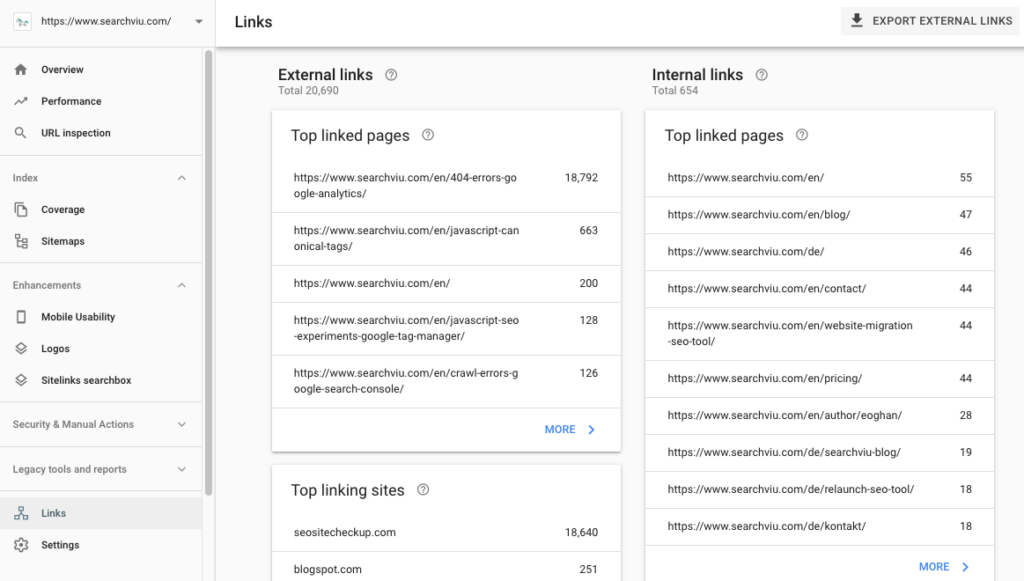
Monitor domain and page authority changes
Domain and page authority are 2 proprietary metrics developed by Moz used to predict how likely the website or webpage is likely to rank in SERPs. Semrush and Ahrefs have their own equivalents - Authority Score and Domain Rating.
Backlinks are one of the factors that are considered when calculating them, so SEOs often use them to track the effectiveness of their link-building campaigns.
The paid versions of the above tools allow you to track historical trends, which is perfect for tracking progress.
Here’s what it looks like in Semrush:
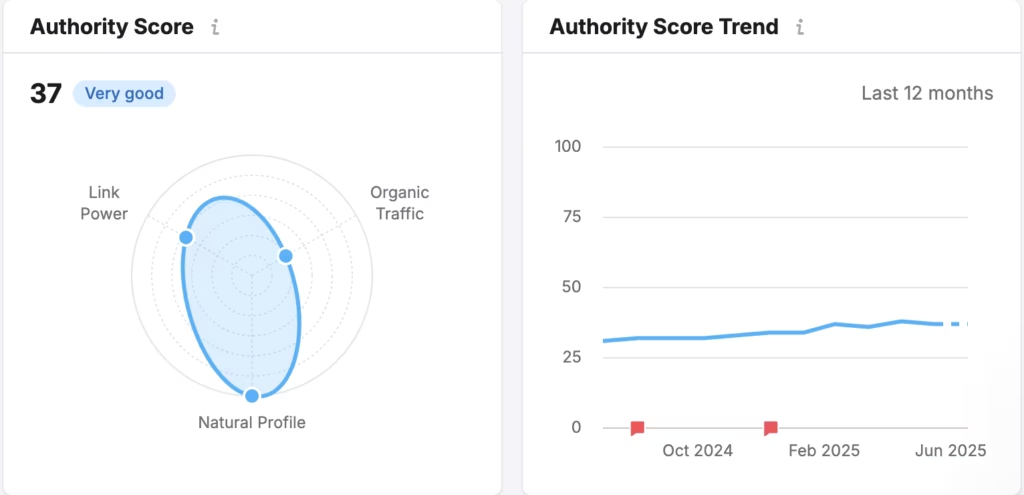
You can check the current DR/DA using our free checker:

Tried and tested link-building tactics
Guest posting, broken link-building, unlinked mentions, or infographic outreach aren’t the only effective link-building strategies.
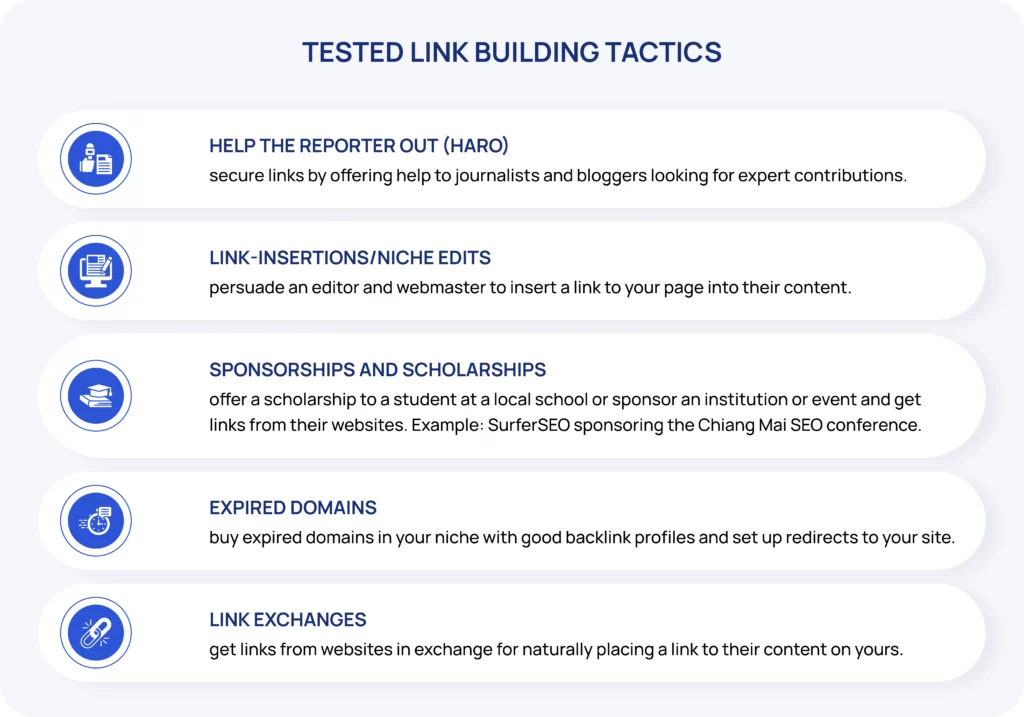
What are others?
- Help the Reporter Out (HARO) - secure links by offering help to journalists and bloggers looking for expert contributions.
- Link-insertions/niche edits - persuade an editor and webmaster to insert a link to your page into their content.
- Sponsorships and scholarships - offer a scholarship to a student at a local school or sponsor an institution or event and get links from their websites. Example: SurferSEO sponsoring the Chiang Mai SEO conference.
- Expired domains - buy expired domains in your niche with good backlink profiles and set up redirects to your site.
- Link exchanges - get links from websites in exchange for naturally placing a link to their content on yours.
Common Link-Building Pitfalls
Not all link-building strategies are legit and can backfire big time if you’re caught using them.
Here are a couple to watch out for.
Stay away from low-quality spammy link networks
To boost your SEO performance, you may be tempted to turn to low-quality or spammy link networks.
Don’t!
While this can lead to a temporary hike in web traffic, it will most likely hurt you in the long run.
That’s because participation in such schemes is a violation of search engine guidelines and can result in penalties, lower rankings and even getting deindexed.
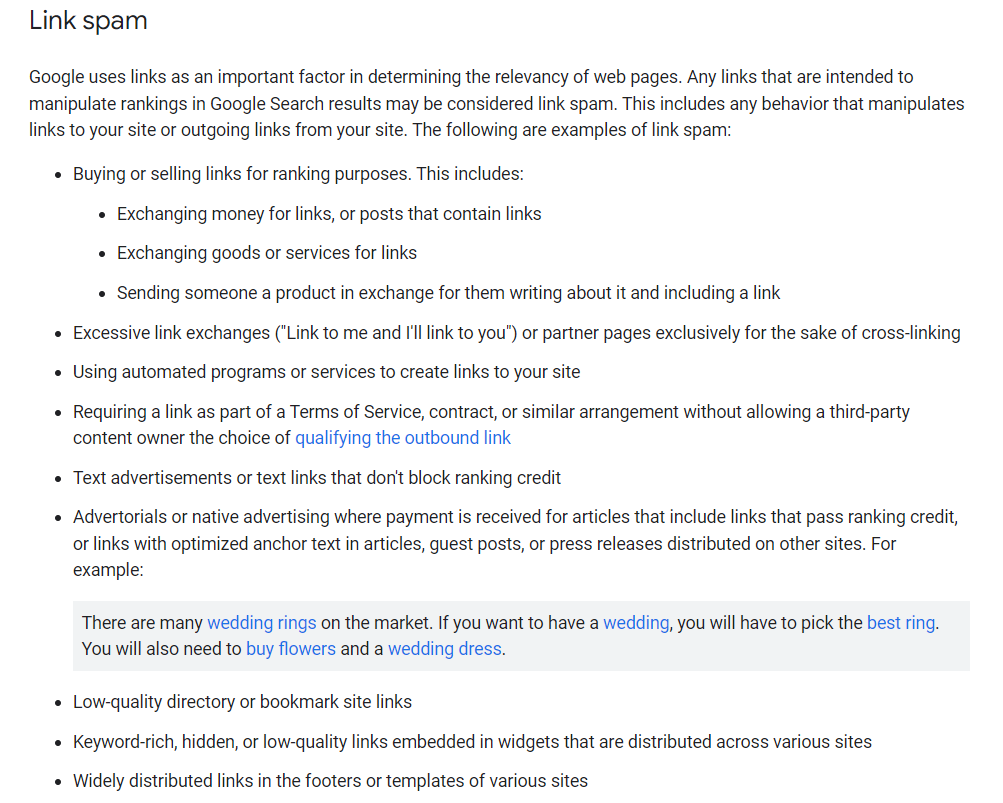
Avoid over-optimizing anchor text
Over-optimizing anchor texts is another shady practice that is frowned upon by search engines.
We talk about anchor text over-optimization when you excessively use an exact match keyword or key phrase as the anchor for your link, especially in an unnatural way that doesn’t fit into the sentence structure well.
Check out these two passages linking back to an article with a slug /white-hat-link-building:
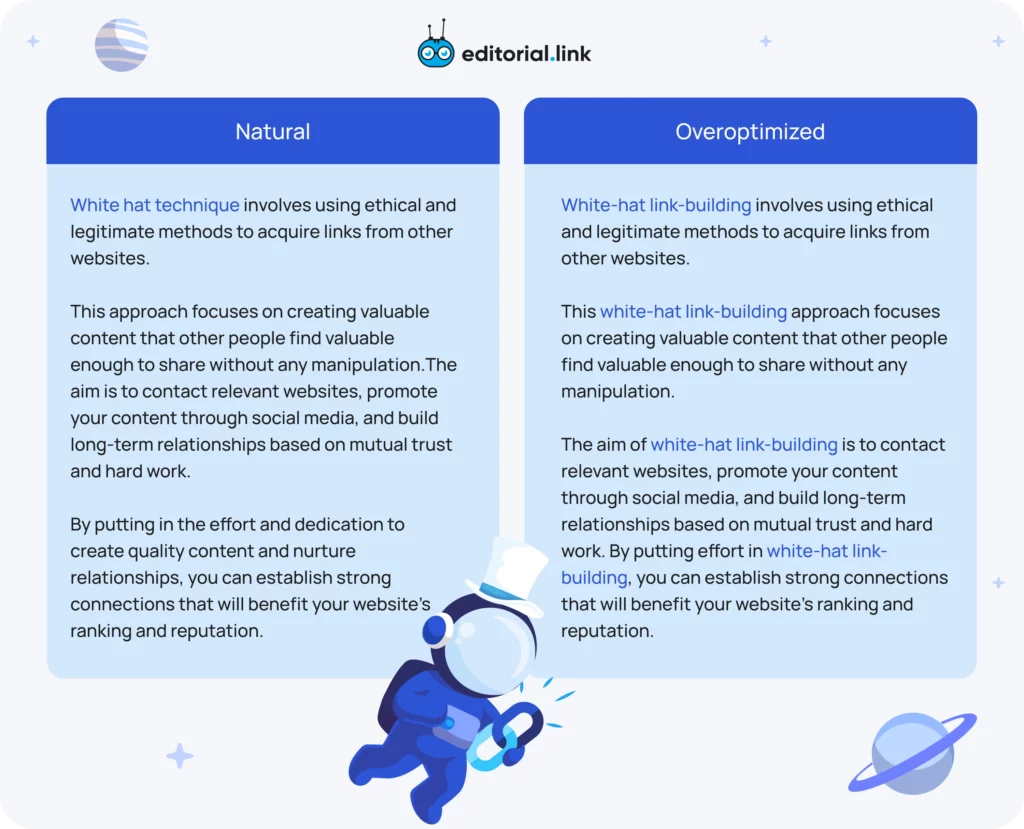
Conclusion
So here you are. That’s how you run a link-building campaign, from setting goals, through prospecting, creating assets, outreach, and monitoring.
The key takeaway is that link-building is not a one-off effort. Instead, it requires consistency and persistence throughout all stages of the process.
However, the time and energy that you initially invest in linkable assets and building mutually beneficial relationships, will make it increasingly easier to build links and drive traffic to your websites in the future.
Need a helping hand with backlinks? Contact Editorial.Link's team for a personal consultation.






